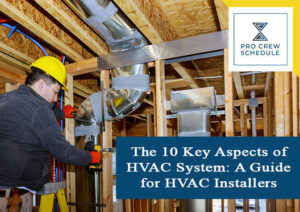Determining and understanding every aspect of the HVAC system can help HVAC professionals maintain the system properly. Knowing the heater and air conditioner’s ins and outs will make the search for issues much easier for the installers. In this way, the prevention of unnecessary and costly breakdowns is obtainable. HVAC systems will work at its peak efficiency for as long as every part is regularly checked and maintained even without additional specifications.
The following is a checklist of some of the most vital aspects of the HVAC system. Take a look below.
1. Compressor or Condenser Coil
The compressor is a significant part of the heat pumps or heat conditioners. It is typically installed outside. The condensers are responsible for cooling an indoor space by releasing heat directly into the outdoor air. It happens when it condenses and compresses the refrigerant from warm gasses to a cold liquid. Moreover, fans blow a considerable amount of air over the compressors to dissolve the refrigerant’s cool and heat.
2. Combustion Chamber
Oxygen should be available for proper combustion. The furnace has been identified that it adds enough air to fuel within the combustion chamber fully. These chambers are also referred to as burners. The heating cycle will usually begin when gas mixtures and air enters the combustion chambers. Next, a pilot light or a glow stick will ignite the mixture, and it will burn in a controllable fire as more air and has moved into the burner.
3. Thermostat
Take note that the best area for a thermostat is near the center of the house. It should be away from occupied spaces. A thermostat usually has temperature sensors, and this sensor decides when the air conditioner and heater will turn on and off, including the controls for the users. The thermostat is connected to the HVAC system through special wires. Most heating and air conditioning systems today usually have one or more thermostats. Every thermostat has the power to control a different zone.
4. The type and design of ductwork
If the ducts are not balanced and sized up correctly, they will never be comfortable for the occupants. It is one of the things that HVAC installers have to be always reminded of. Using project management software, it is easier to monitor each component installed in the system, especially the ductworks. Moreover, insulated round ducts are proven to be more efficient than the others and lasted longer.
5. Balance dampers in the ductworks
Since HVAC professionals know every part of the system, they know what parts and areas are the noisiest. The noisiest place and probably the worst area to adjust the cooling and heating amount are at the diffuser grille. That is why it is imperative to install the balance dampers some distance from the diffusers.
HVAC installers are expected to be skilled in this area and equipped with the right tools. Some of the best tools used today are software applications designed for efficient project management. Construction scheduling software is one of the advanced tools used today in the industry.
6. Location of the indoor units
Attic-mounted furnaces are found to be very vulnerable with leaks, and it causes ceiling damages. However, issues like this can be resolved once HVAC experts will prioritize and take special system designs. Two of the most common methods applied to solve such problems are the drain line and secondary condensate plans to the exteriors. The furnaces mounted in the closets, specifically at floor level, are less prone to water damage and leaks.
Also, the furnace is much easier to service or install, which is very advantageous. Locating indoor units or installing furnaces is best achieved in implementing construction projects management. With this way of managing, it is much easier to organize tasks, resources and the crew involved.
7. Return-air considerations
Be always reminded that a stable amount of air should leave the room. In that way, it is easier for conditioned air to enter the room immediately. If not, there might be no spaces for the conditioned air to occupy. The ideal thing to do is every room must have a return-air diffuser and an entering-air diffuser. However, extra expenses such as diffusers can be rejected if ever adding transfer grills is considered.
8. Air-filter location
Air filters play a vital role in the system, and HVAC installers have to determine where to best be positioned at a particular place. Usually, air filters must be located where occupants can able to reach it easily. The filters also have to be replaced now and then like every 3-4 months. There are times when HVAC installers give a detailed guide for their clients on how to monitor and check these filters separately.
During monthly inspection, air filters, including other components, are checked regularly. HVAC projects managers can use advanced software designed to make the work easier, faster, and productive.
9. Outdoor Unit Placement
The placement for condenser coil or outside units must be faster and should be away from bedroom rooms. HVAC installers must first check the place and rooms to visualize the placements and installations of these parts. Furthermore, it is essential to place the outside units far away from the windows because the noise reduction is easier.
To manage a project in this HVAC field is an extreme pressure for professionals. Good thing that there are advanced software tools used today designed for different trade projects. Tools like this are made for project management purposes making team collaboration much more robust and consistent.
10. System Efficiency
The efficiency of the system unit is determined in its running costs. It is crucial to obtain a system with much higher efficiency to avoid high energy bills. HVAC professionals often suggest to clients the best system for their homes, including the models proven to have higher efficiency. Moreover, efficiency is crucial in ensuring that every appliance will remain economical for an extended period.
To immediately get the efficiency of the unit correctly, make sure to check the SEER ratings. SEER stands for seasonal energy efficiency ratio and a basis for getting the unit efficiency. The lowest to get is 13, and the highest SEER rating available today is 20. The economic benefits of higher SEER ratings are immense despite the higher initial cost.
Basic Installation Procedures of an HVAC system: A Guide
It is crucial for professionals working in this field to take a closer look at what truly goes on in HVAC installation quality. Being an expert on each aspect or component is not just enough. Understanding the entire process will help in making informed decisions for the property’s heating and cooling needs. Keep reading below to learn more.
Step 1 – Load calculation
First and foremost, it is essential to measure how much space an HVAC system needs to cover. The proper use of tools is much faster and precise whenever measuring every room’s size, particularly the areas where cooling and heating are needed. It is also equally important to understand the size of the system and the size of the property.
Improper calculation of the system’s load and incorrect sizing can lead to premature failure of the system. To avoid this type of issue, ensure to follow proper guidelines. Using project management software, sorting out tasks, monitoring every project phase, and manage crew is much efficient and faster.
Step 2 – Search a suitable location for the units
The second thing you will do is to identify where the air components and furnace should be located. Though it might be evident in some areas, it might not work on residential properties like homes. It might be the situation as it applies to outdoor units. Besides, the placement of the components can significantly affect efficiency. Hence, it would be best if you choose wisely.
Step 3 – Install all essential components.
Installing all of the necessary components for the system is the next step to do. This stage is where the process can get a little bit challenging and tricky. HVAC installers need to be equipped with the best tools. They are not just installing air conditioner and furnace but also having to connect it properly to the ductwork and power house.
The system might fail to function without proper and safe power. You might put the occupants at risk.
Step 4 – Inspect thoroughly and test the system
Once everything is finally set and installed correctly, the next thing to do is to inspect further and test every aspect/feature of the system. Start looking for safety dangers, leaks, and non-functioning components. This phase often requires training and precise tools to prevent safety risks and danger, especially to the occupants.
Lastly, factoring the possible costs of a new system unit can be broken down into several areas. Installers and technicians search to see if the property is up to city code to conduct installations. They also consider additional electrical needs and inspect if the ductwork is currently in a functional condition.
Key Takeaways
Being a newbie to the HVAC system industry, you should learn and understand further every crucial part of the HVAC system. Mastering all of the features is essential to your HVAC career, yet you shouldn’t stop there. The industry is growing and continuously expanding, and it is important to be always keen on all the latest trends and new technologies.







